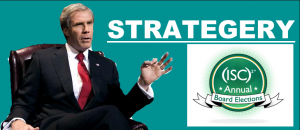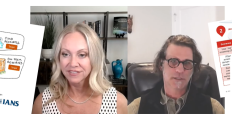Once again, I bring you the unfiltered content of JJ’s mind through the blog-o-sphere. What I’m about to share are my opinions and do not represent those of anyone else on the board, near the board, under the board, at the organization or any any way affiliated with (ISC)2. My opinions are not always the popular ones, but they are mine.
In my last post, I talked about the fundamentals of the (ISC)2 Board and elections. Now I’m going to dive in to a specific topic and a suggestion I hope you heed, not just now but for years to come. Remember, kids — Only you can prevent forest fires (or ineffective Board members).
Why strategy should drive your vote
The fact that the Board members drive strategy is huge because it hasn’t always happened and YOU HAVE AN OPPORTUNITY TO FIX IT. (ISC)2 is an organization that started as a small grassroots effort, and was expanded and grown through extreme care and feeding, and lots of sweat and tears, to an international organization with nearly 125,000 members. I’m not here to challenge or attack what past board members have done. Their accomplishments on and off the board are nothing shy of amazing. But I’ll share some of my secret inside voice dialogue with you.
As a friend and mentor (Brian Jones) explained to me years ago, when you’re working “in” the business, you’re not working “on” the business. “In” the business is the tactical daily operation, and “on” the business is the big-picture strategy. Well, when you have a small group who has, solely, been responsible for trying to juggle both for a long time, it becomes hard to separate the two, and I think that’s exactly what happened over the course of past years when the Board was comprised of a rotation of many of the same faces. Those faces helped shape and grow a successful organization, but that circulation of talent came at a cost to the organization’s strategy and growth.
What happens when strategy fails
The organization has succeeded not because of the Board’s strategy, but despite it, or perhaps even “in the absence of it”, is a more appropriate term. At the end of the day my friends, you have no one to blame but yourselves — you the voting member — you are responsible for choosing a board that can lead strategy. The board will ensure the organization executes on it. But if you fail to select board members who can succeed at strategy, then the organization will not have the leadership and direction it needs to grow in the myriad ways you want. All those things you tweet or rant about, those things can be fixed (well most of them can; some of them can’t because y’all are just unreasonable and like to be snarky).
Not just this election, but all. Choose wisely, always.
Succession, rotation and why you care
In October 2015, after years of struggle, the Board successfully passed more stringent term limits which were designed to encourage a rigorous rotation of board members, and therefore drive an influx of new talent to the Board. This coming year, starting in 2017, is the first full year and cycle under the new term limits, which limit a member from serving more than six out of any ten consecutive years. (New bylaws can be viewed here, read section III-4.) You can also see the Special Meeting of the Members Minutes from that October meeting, and you’ll see I was there in-person as an officer along with Dr. Schou (then-current Chairman).
What that means is that succession, succession planning and succession strategies will be gravely important. Capturing decisions, documenting processes, and enforcing accountability for the Board as a whole, the Board Committees, and the individual contributors on the board will be a huge factor in the success of the organization’s growth.
What the board will look like next year
Speaking of term limits and succession. If you were like me, you’ve been squawking about getting new blood on the board and rotating out some of the old hats who have been in the mix for years, sometimes decades. Well, we got what we wished for, but you should know the extent to which there will be fresh blood in 2017.
There are 13 board members, and there’s a 3-year term and a 1/3 rotation each year. So it goes 4-4-5 — meaning in one year, 4 board members roll off, and 4 slots are filled, then again the second year, and then the third year there are 5 board members who roll off, and 5 slots to be filled. The 2017-2019 term is a 5-slotter folks. There are only two of us on the slate who have served a term before. The brilliant and hilarious Greg Thompson and I are the only two with board experience in this group. And the other 8 board members who are not in rotation this year? Well, they’re all in their first term except Wim, who is serving his second term. So if Greg and I are re-elected, there will be 3 people serving their second (and final) term, and everyone else will still be in their first years of service. That’s a significant change from the past years, where some board members had served the organization for 10+ years.
But as refreshing and wonderful as all that freshness may be, there will be a cost to the organization along with the opportunity. If we’re not careful, the organization could suffer in its first year losing so many key contributors.
As I’ll share in my next post, this is one of the drivers that led me to accepting the nomination to run again. I was pretty well set on exiting the board, but I know I can help put processes and structure in place for succession, and that succession within the board is what will help grease the gears for all the subsequent boards, committees, and board members, and ultimately I think it will have a major impact on the growth of the organization, and the value to the members.
# # #








